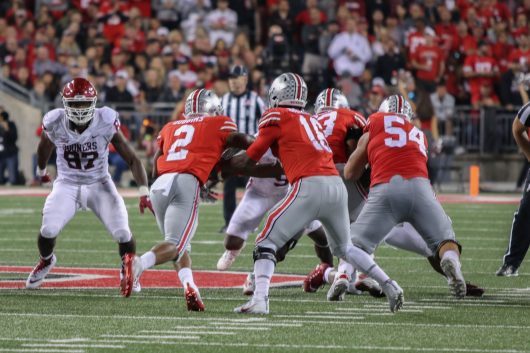
Senior quarterback J.T. Barrett (16) hands the ball off to freshman running back J.K. Dobbins (2) during the Ohio State- Oklahoma game on Sep. 9. Credit: Jack Westerheide | Photo Editor
A week after dropping just 16 points on an Oklahoma defense that gave up 14 points to Tulane a week later, Ohio State handled Army with ease, putting up 38 points and 586 total yards.
Unlike in the Buckeyes’ season-opening 49-21 win against Indiana that included seven three-and-outs and two touchdowns of 50-plus yards, their offense relied on elongated, methodical drives.
Against Army, Ohio State seemed to revert more to its previous identity, driving its offense more with a strong ground attack and shorter passes than attempting to force big plays through deep passes.
Redshirt senior quarterback J.T. Barrett said using passes at or behind the line of scrimmage and option plays are critical to the success of the offense. They put defenses on alert.
“With run-pass options, you really can’t just be heavy loaded whether it be run or pass. You can’t have guys sink on the pass; you can’t have guys loaded in the box,” Barrett said. “On those plays, you get both. You have to be prepared for both. You have to be disciplined with your eyes.”
Deploying the run-pass option gives Barrett three options on the play: keeping the ball, handing it off or passing. This play gives the team a weapon against defenses that prevents opposing teams from making assumptions based on any given play.

Ohio State redshirt senior quarterback J.T. Barrett (16) throws a pass to junior wide receiver Terry McLaurin (83) in the first quarter of the 2017 OSU- Army game on Sep. 16. OSU won 38-7. Credit: Jack Westerheide | Photo Editor
Though Barrett has received a bevy of criticism in the season’s first three games, with a crescendo coming after the loss to Oklahoma, he has accounted for more career touchdowns than anyone else in the history of the Big Ten.
“[Barrett is] a solid, adequate runner,” co-offensive coordinator Kevin Wilson said. “He’s a solid, adequate passer that can put them both together. And when both things get working, he makes your offense complete.”
Though Barrett and the offense have succeeded with run-pass options and short passes, they still want to find a way to include deep shots down the field into the offense. In order to do that, Ohio State believes it must draw the linebackers out wider and the safeties closer to the line of scrimmage to open up space downfield.
“We want to stretch the defense horizontally because that opens up our inside zone and our over the top shots, makes defenses come down,” wideout Terry McLaurin said.
For an offense that often discussed increasing the proficiency of its deep-ball capabilities during the offseason, this might seem illogical. But given Barrett’s propensity to overthrow open receivers down the field, or receivers dropping passes or failing to reel in contested passes, Ohio State has had to move away from its vertical passing game.
In the first half of the Army game, the only two times the offense stalled occurred when the offense strayed further from its identity, attempting to force deep passes while in Army territory. The results were a punt from Army’s 33-yard line and a field goal from Army’s 16-yard line. Each of the previous two plays before the respective kicks were failed pass attempts of 15-plus yards.
Regardless of the failed drives, Ohio State averaged 8.5 yards per play versus the Black Knights, compared to 5.1 yards against Oklahoma and 6.9 versus Indiana.
“We got the ball out in space to our fast playmakers in the slot,” McLaurin said. “We blocked well on the edge and you saw, we took a couple of downfield shot and that opened up because we stretched the defense horizontally.”
Given Saturday’s game against UNLV, a team that has given up 416.5 yards per game, and matchups with Rutgers and Maryland on the horizon, the Buckeyes have time to mold the offense to a style it desires.
“We’re focused on building on what we did last week, our horizontal game, taking some vertical shots, some complements,” McLaurin said. “And I feel like that’s what’s going to help us get better when we start getting into Big Ten play.”


